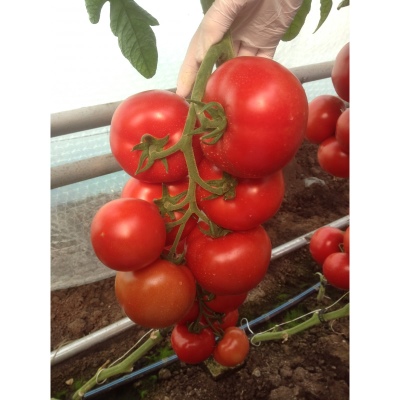
- Authors: Reinink Kornelius
- Year of approval: 2018
- Category: hybrid
- Growth type: indeterminate
- Appointment: fresh consumption
- Ripening period: mid-early
- Growing conditions: for open ground, for film greenhouses
- Marketability: high
- Leaves: medium, green
- Unripe fruit color: light green
The Zulfiya tomato variety was approved for use in 2018. She is hybrid. Her type of growth is indeterminate. You can eat vegetables fresh, they are often used in the preparation of various dishes.
Description of the variety
The Zulfiya variety belongs to the mid-early species. These tomato bushes have medium-sized leaves with a rich green color. Their inflorescence is simple. The peduncle is articulated.
The main qualities of the fruit
Ripe tomatoes have a bright red color. Their shape is flat-round, slightly ribbed. The flesh of the vegetables is quite dense, but juicy. The color of the unripe fruit is light green. The mass of one vegetable is approximately 137-165 grams.
Taste characteristics
Ripe tomatoes have good taste. They are used for fresh consumption. And they are also often used to prepare various salads and other dishes.
Ripening and fruiting
The Zulfiya variety belongs to the mid-early varieties. Ripening begins approximately 105-110 days after planting. The variety has a rather long fruiting period.
Yield
This tomato variety is characterized by a high yield level. When growing bushes under a special film cover, you can collect 10-12 kilograms from 1 square meter.
The timing of planting seedlings and planting in the ground
Sowing can be carried out already from March. In this case, planting in open soil can be carried out in May.

Growing tomato seedlings is an extremely important process, because it largely depends on whether the gardener will be able to harvest at all. All aspects must be taken into account, from seedbed preparation to planting in the ground.
Landing scheme
First, seedlings are planted. In this case, you will need to prepare the required number of containers for disembarkation. Earth is poured into them, first it should be mixed with dressings, you can use minerals.
And also the seed material is recommended to be thoroughly treated with fungicides beforehand. Such a procedure will help protect plants from diseases in the future.
Small grooves are carefully formed in the ground, and seeds are poured into them. After that, everything is lightly sprinkled.
All containers with soil and seeds will need to be kept in a dry place at room temperature until the first shoots appear. When the first shoots have already appeared, they can be transferred under the lamps.
With the onset of spring, prepared young seedlings begin to be planted in open ground. Separate bushes should be placed at a distance of 55-60 centimeters from each other, so that later grown plants do not come into contact with their leaf blades.
All planting holes will need to be well moistened with clean water in advance, the earth should remain slightly damp. And also you need to immediately add nutritious useful dressings there, you can purchase ready-made complex fertilizers.
When the plants are planted in open ground, it is better to immediately tie them to the supports. And also the land around the vegetation must be well moistened.

Growing and care
Only proper and timely care will allow you to get the maximum healthy harvest of vegetables. We must not forget about watering. This culture requires moderately moist soil; for this, rare, but quite abundant watering is used.
In warm weather, watering the ground is worth once a week. If the weather is sultry and too hot for a long time, then the number of these procedures should be increased.
It is worth remembering about root dressing. This variety requires at least three additional dressings in one season. At the same time, it is recommended to alternate organic and mineral formulations to ensure saturation with all important nutrients. During flowering periods, the bushes can be additionally sprayed with a solution of boric acid.
To increase yields, it is also necessary to properly shape the bush. For this, shoots are removed on each bush, only a few of the strongest of them remain.
Do not forget to periodically mulch the ground. This procedure allows you to increase the level of productivity, significantly speeds up the process of ripening vegetables, and also makes it possible to retain moisture in the soil for as long as possible.
For mulching the soil, hay, humus, sawdust are most often used, sometimes a homogeneous mixture of straw and manure is also made.




A plant needs different micronutrients at each stage of growth. All fertilizers can be divided into two groups: mineral and organic. Folk remedies are often used: iodine, yeast, bird droppings, eggshells.
It is important to observe the rate and period of feeding. This also applies to folk remedies and organic fertilizers.
Disease and pest resistance
Like many other varieties, Zulfiya tomatoes can suffer from various fungal infections. Most often they occur due to excessive moisture levels. Such diseases can lead to the complete death of the bush. In this case, the affected plants must be immediately treated with special chemicals for horticultural crops.
And also tomatoes can be affected by various insects, including bears, nematodes, wireworms and spider mites.To combat such pests, special insecticides are best suited, the compositions "Iskra", "Aktara", "Fitoverm" are more often used.



























































































